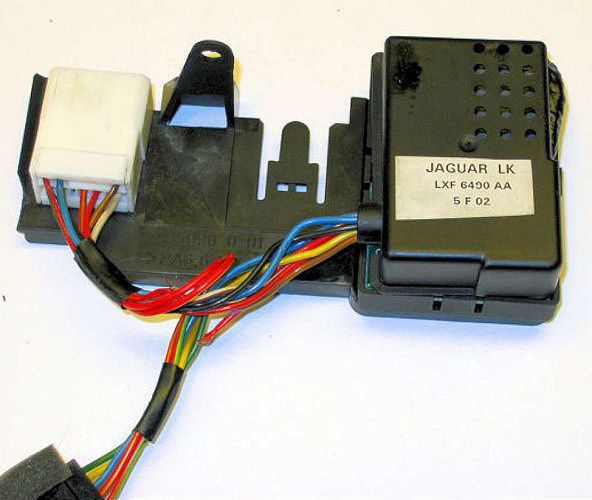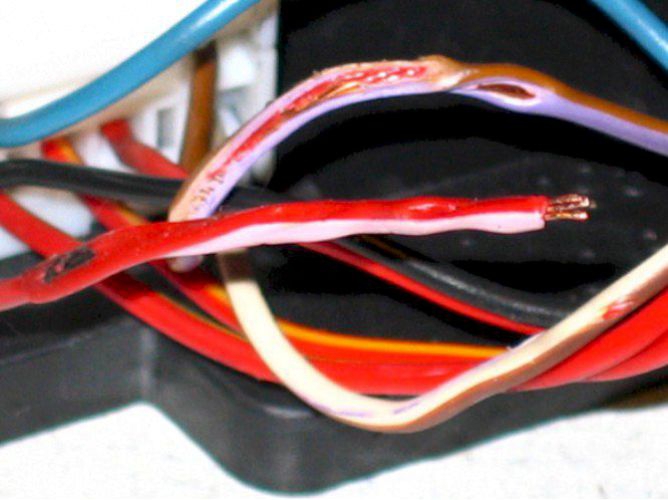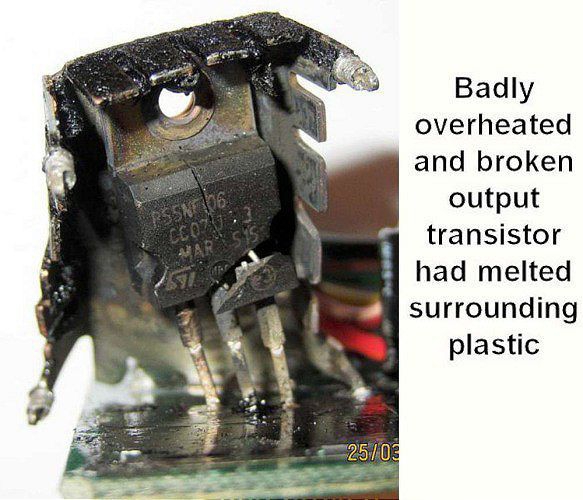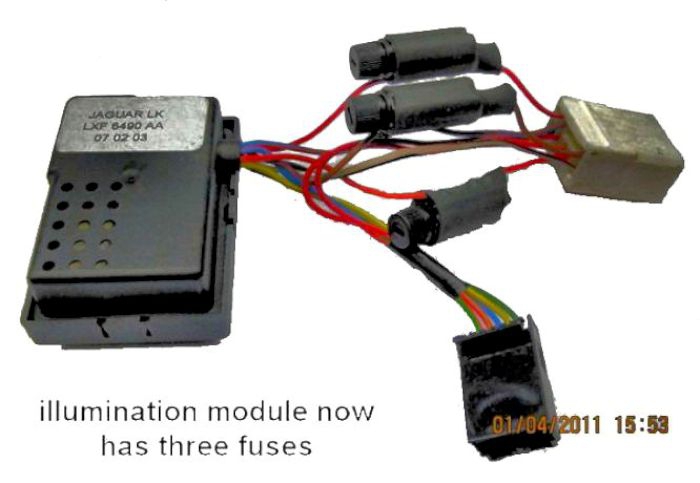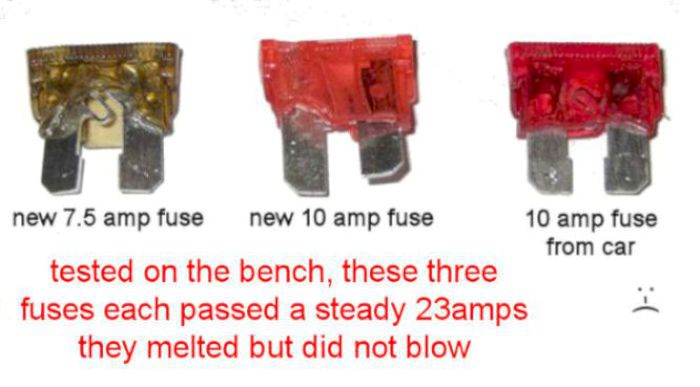Illumination Control Module
The X300 dial lamps are driven by an Illumination Module which often goes faulty
The variable intensity X300 dial lamps are driven by an Illumination Module which can produce various symptoms - dial lights on all the time; intermittent dial lights; no dial lights; and overheating, smoke, smell and meltdown
from the Jaguar Battery Care Manual:
for an XJ6 the quiescent current after 60 minutes should be less than 43 mA (30 mA for an XJ8)
NOTE that the illumination dimmer control on the XJ6 is fed DIRECTLY from the battery via 10 amp fuse 2 in the left-hand heelboard fusebox so is live all the time. When the unit starts to go faulty the dash lights can come on even when all else is switched off - basically the FET is failing. It can also fail to earth which is the reason my wiring nearly burnt out and I had to disconnect the battery VERY quickly when smoke came out of the dash.
The fault:
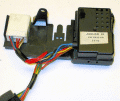
In my case revealed itself by smoke and a smell of burning from somewhere near the dashboard; I was miles from home and emergency action had to be taken.
This proved to be failure of the Illumination Control Module that is a complicated way of adjusting the intensity of the dial lights.
The story:
Day 1
I had been enjoying my Sport for the last few days when one evening, on the way home from work, smoke came out from the dash area.
Quick dash to the boot to disconnect the battery - no 10mm spanner in the toolkit (sort that in the morning!) - but the under bonnet toolkit luckily had one. Disconnected the battery, smoke slowly subsided.
The only clue was that the dial lights had gone out shortly before the smoke appeared. The dial lights had failed a few days ago but were OK after replacing the blown 10A fuse (passenger-side rear footwell fuse #2); maybe it was a warning of things to come. The blown fuse should only feed the dash lights and, for some reason, the heated mirrors.
Whip off the under-dash cover; out with the instrument pack. Nothing hot here. Fish around in the wiring -!!!!!!! - ouch! There is a red-hot blue connector (FC4) leading from somewhere up inside the steering column and also a very hot unit (can't find out what it is by the roadside) in the lower end of the steering column lower shroud.
Fortunately I had been quick enough to isolate the battery before the wiring turned into a bonfire.
So - disconnect the hot blue connector (ouch again) and reconnect the battery. Drive home no dial lights, instruments, flashers or main beam - but what remains seems OK and the engine goes!
Get home, disconnected the battery and left it to think over what might have happened.
Day 2
Further research has isolated the problem to a low resistance (0.75 ohm) somewhere in the switch-pack etc illumination supply wiring - the circuit that goes all over the car to operate the lights in the door switches and dozens of other places.
The illumination control module is well and truly fried trying to push power into the fault. I will investigate further tomorrow and no doubt for some days after! Fingers crossed there aren't any more wires fried; the ones I can see look OK though they got rather hot. The car is nearly in kit form with so many panels off.
Hopefully I shall have better news shortly!
Day 3
OK - story against myself.
Having dismantled half the car and disconnected all the relevant plugs and sockets, I found that there is no leak (ie melt-down) in the harness.
When I connect the lights up, there appears to be a very low resistance suggesting a short circuit in the wiring. But I forgot temporarily that a cold lamp has lower resistance than a lit lamp and with upwards of 20 lamps in the circuit, the cold resistance would be very low.
The resistance of one lamp cold is 13 ohms; of 20+ lamps would be around 0.75 ohm which was the reading I was getting and thinking I had a short.
Under operating conditions, with each lamp taking .1 amp (1.2 watts) 20+ lamps should take a current of 2+ amps and this was then proven using a current-limited 12 volt supply (can't be too careful).
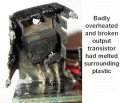
What if the module itself had failed? By now it was too late for the MOSFET power transistor which regulates the variable voltage to the dial lights - it was blackened and dead short! Several of the wiring connections were melted and shorted together so no clues there beyond clear evidence of excess current.
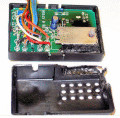
The disconnected plugs in the switch lighting circuit were reconnected one by one and all seems well as the current rises to a steady 2.4 amps.

In its dying throes the module could well have taken excess current and so overheated itself and the close-by wiring.
It is interesting to note that the illumination module had probably been changed before as it had a 2002 date on it - also it was not secured properly and there were tie-wraps holding everything together.
Now I think I know what the problem is, I checked back through the posts on the forum and yes, there are many reports of this module (LXF6490AA - Illumination control module) failing.
I thought it was odd these modules are still available off the shelf - obviously a fast-moving part!
From now on my battery compartment will permanently hold a 10mm spanner and a screwdriver (as a lever to get the battery connector off quickly). Later - I have now fitted a battery switch.
Day 4
Having tested for any damage to the wiring looms, the car was put back together.
The new module arrived and was fitted and tested OK - more-or-less proving my diagnosis (module failure) to be correct.
In the event I decided to leave the replacement illumination module hanging (good old cable ties) free in a position where it will receive a little air should it ever start to get hot. There are vent holes in the top of the module to allow heat to escape - but the way it was mounted in the steering column the holes were partially covered and mounted sideways. As anyone knows, heat rises!
I hope it never happens to any of you - but I now have a quick-disconnect battery switch just in case . . . . .. :-))
Three months later . . . :-(
Dial lights all went out!!!
After a few basic tests it seems that the "new" Illumination Control has failed.
Not wishing to buy yet another, I dismantled it (it wasn't burnt out like the original) and remade several of the joints on the PC board.
Plugged it back in, wiggled the wires and it worked - for a while. I found one of the CRIMPED connections on the PC board was intermittent and with a gentle pull the wire came out.
Soldered back in and now I have a fully working Illumination Control Module (though for how long I wonder?)
and a further month later . . . . :-((
More smoke and a well burnt-out unit again. :-(( nip into the boot to turn the battery switch off. Remove the dash undertray etc and drive home without any dial lights.

Another unit purchased - this was also faulty (though not burnt out). Replaced the MOSFET and ADDED FUSES IN THE INPUT and BOTH OUTPUT LEADS - also shorted out D5 which could allow negative spikes on the earthy rail.
For future reference (I hope not): - measured at fuse 2 left-hand kickboard
engine off - battery volts circa 11 volts - current varies between 0.95 and 3.23 amps
engine running - battery volts circa 13 volts - current varies between 1.0 and 3.58 amps
If there is a fault in the car wiring, I hope one of the new fuses might blow to give an indication of where the fault lies.
FUSES - A WARNING TO ALL - when is a fuse NOT a fuse?
If a blade fuse looks like a blade fuse and has a 10amp rating marked on, you assume it to be a 10amp blade fuse - WRONG

Out of interest (together with an element of suspicion), I tried to blow two unbranded 10amp fuses. They took 23amps continuous current - got hot (melted the plastic) but didn't blow. Same with a 7.5amp fuse - took 23amps without blowing. This means that, should something go faulty then at least 23amps could pass continuously into the fault. This would most likely result in smoke and a damaged wiring loom.
I checked the few original remaining fuses I had, marked Littelfuse - they all blew at rating plus about 20%, no more. Perfection.
SO there are good fuses and bad fuses. The eBay listings only seem to offer unbranded types - having been caught out once I won't be going down that route again. The original fuses for my Jaguar were made by Littelfuse - so after some hunting I ordered a set A04030 to be sure of having fuses that will actually BLOW when overloaded.
DO NOT BUY UNBRANDED FUSES
check ALL your fuses are marked Littelfuse (or other recognised brand) NOW
